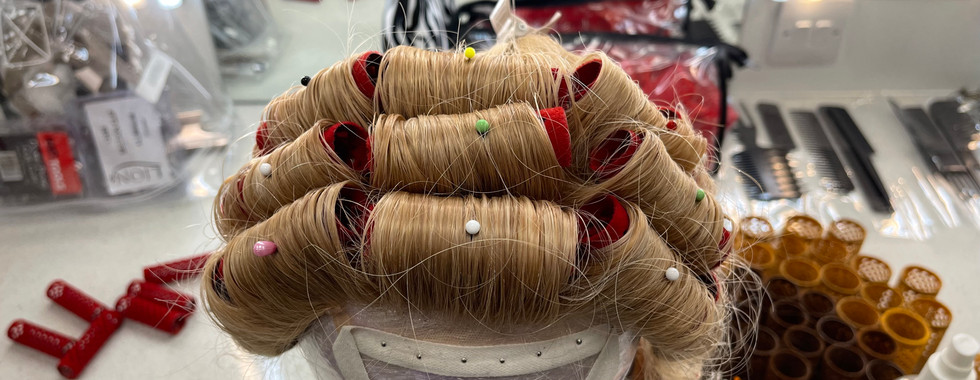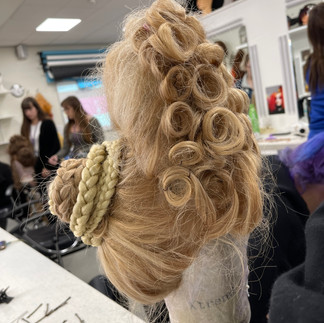The Romans
- alyshajadeoconnor
- Sep 23, 2021
- 5 min read
Updated: Jan 17, 2022
Hello and welcome back to my blog! This week we are going to be exploring and recreating a very symbolic hairstyle from the Roman era.
The Romans took their appearance very seriously as they believed proper dress and grooming practises were a sign of wealth, status, age and religion. Roman men sported short hair with no facial hair, shaved off with razors which were made from sharpened bronze (Sherrow, 2006).
DID YOU KNOW? Men were not actually allowed into their places in the senate unless they shaved their beards (Sherrow, 2006).
In early Roman times women wore their hair in a bun, but at the time of the empire women wore their hair curled and braided as this was seen as more fashionable. Wealthy women wore gold jewellery such as necklaces and earrings and wore cosmetics by whitening their faces with powdered chalk, they used plant dye to colour their lips and used soot to darken eyebrows. Both men and women wore lots of rings - even poor roman's wore rings as they made them from bronze (Bingham, 2009).
Industry have used this version of women's hair and makeup in TV shows such as 'Rome'. As you can see in Figure 1, the woman has very curly braided hair which is historically accurate.

"So fierce their quest for beauty, so many tiers and storeys, the weight of hair built up on her head!" (Juvenal and Clauson, 1998).
The quote above has been taken from a collection of poems called the Satires written by Juvenal in the early 2nd century. This gives insight into how women wore their hair in this era, which can be supported by the statues and paintings that still stand to this day (Figure 2). Statues and paintings are the most reliable sources when researching into this era because cameras did not exist.

Because their hair was worn so tall, a wig cage was created using wire, netting, and crepe hair (Figures 3, 4, 5 & 6). Wig cages are very useful because they allow you to add height or width without adding lots of weight. Most wig cages are made of very lightweight wire and netting. They're especially useful in period hairdressing because some historical hairstyles are so large that teasing and stuffing is not sufficient (Ruskai and Lowery, 2013).
I was pretty confident when creating the wig frame. The wire stayed straight and didn't have many bumps in it. I used a pair of pliers to wrap the ends of the wire up, which allowed me to get it very tight. This was then secured with tape and netting was sewed on tightly. I was happy with my wig frame up until this point. Crepe hair was added to pad it out, however, too much was added so the frame lost its shape a little bit. This caused me to dislike the wig frame in the end as it looks too bulky.
Figures 3, 4, 5 & 6: Wig Frame Making (O'Connor, 2021).
Human hair wigs are usually wet set with rollers or pin curls, and left in a special wig oven to dry for a few hours, more often over night and are then dressed out in the requstyle (Delamar, 2003). They can also be set with heat, such as heated rollers. Personally, I think doing a wet set on a wig gives a much nicer curl, gives more volume and the curl lasts longer as it has to be set in the rollers for multiple hours, whereas using heat means the curl has more of a chance of dropping, especially on fine or very clean hair. For this style, a wet brick set was done (Figures 7, 8, 9, 10, 11 & 12), leaving out the crown of the head as this is going to be tied up in a bun, so no set was needed.
Figures 7, 8, 9, 10, 11 & 12: Wig Set (O'Connor, 2021).
Having some previous experience in hairdressing meant that doing the roller set was not too challenging for me, however, there is still room for improvement. I need to work on getting the rollers tighter, as some of the set is loose at the sides. Custom Wig Company (2014) says that putting too much hair in the roller and taking a section that is too wide for the actual roller are the most common mistakes made with roller sets. They say to aim for sections that are about ¼” thick and that the section of hair should be a little narrower than the width of the roller. This is where I believe I went wrong with this set; taking sections that were too wide to fit on the roller, as some sides are loose and stick out. In future sets, more care will be taken when choosing the width of each section, ensuring each section is just narrower than the roller.
Figures 13, 14 & 15: Roman Hairstyle (O'Connor, 2021).
Pictured above are the final images of the Roman Flavian hairstyle created by myself. As an overall image I think I have achieved a good standard considering I have never created or applied a wig frame before, and the fact I have also never created a hairstyle like this. Hairdressing is a weakness of mine, so to be able to create a hairstyle like this, regardless of the untidiness, is an achievement for me.
The bun at the back was made up of several plaits, some of which were the wigs hair and some was extra plaited hair added in. You can see which plaits were added in due to the major colour difference between them both. This was due to a lack of hair colours that the university have in stock. If the colours matched, then the overall style would look more put together.
The pin curls were the hardest part of the hairstyle because the hair was so soft. They should be more even in their sizing as some are larger and looser than others. If this hairstyle was to be created again, a small bit of wax would be used when creating the pin curls as it will allow for more control and will assist in holding the hair in place, but will still allow for movement unlike hair gel which dries down and goes stiff (Sharad and Vedmurthy, 2018). The curls should also be pinned in with blonde grips rather than with brown grips because you can see them in some of the curls, and if this was to be worn in film or TV, then the grips would need to blend with the hair colour or be unseen. This will be worked on and improved over the next semester as each hairstyle is created.
Thank you for reading my Roman blog, next week I will be looking at the Victorian Era! Final images of the wig can be found in the Period Hairdressing Portfolio section of the website.
See you then:)
Alysha
Reference List:
Bingham, J. (2009) How People Lived in Ancient Rome, New York, The Rosen Publishing Group Inc.
Custom Wig Company. (2014) How to style wigs with rollers [Online]. Available at https://customwigcompany.com/styling-wigs-with-rollers-3/ (Accessed 5th January 2022).
Delamar, P. (2003) The Complete Make-up Artist, 2nd edn, Illinois, Northwestern University Press.
IMDb. (n.d.) Rome (TV Series) [Online]. Available at https://www.imdb.com/title/tt0384766/ (Accessed 3rd January 2022).
Juvenal and Clausen, W. (1998) The Sixteen Satires, London, Penguin Publishing Group.
Litavicci, I. (2014) Flavian Hair [Online]. Available at https://strangewayes.wordpress.com/2014/10/19/flavian-hair/ (Accessed 3rd January 2022).
O'Connor, A. (2021) Roman Hairstyle [Own Images]. York College, York.
O'Connor, A. (2021) Wig Frame Making [Own Images]. York College, York.
O'Connor, A. (2021) Wig Set [Own Images]. York College, York.
Ruskai, M. and Lowery, A. (2013) Wig Making and Styling, Burlington, Focal Press.
Sharad, J. and Vedamurthy, M. (2018) Aesthetic Dermatology, New Delhi, Jaypee Brothers Medical Publishers (P) Ltd.
Sherrow, V. (2006) Encyclopedia of Hair, United States of America, Greenwood Press.































Comments